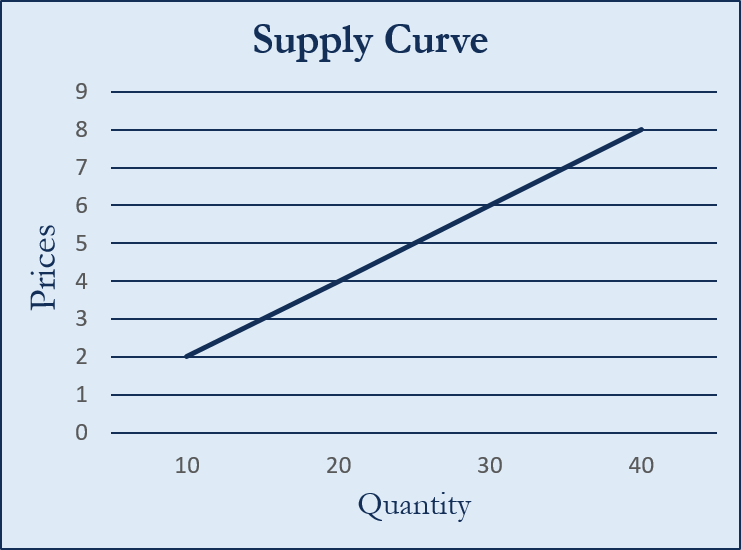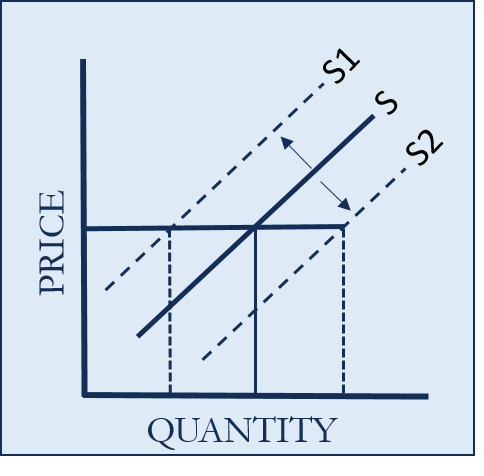Law of Supply: Meaning
The Law of Supply is one of the most basic economic concepts that give an idea of the quantity of goods that a business will produce at a given price. As per this law, the supply of a product will increase with the increase in price. And a drop in price will lead to a drop in the supply of the product.
In simple words, we can say that this law shows the producer’s behavior when the price of a good or service goes up or down. As the prices go up, producers prefer to increase the supply to benefit from the rise in the prices. And, when the prices drop, producers reduce the supply as the profit now is less.
This law, however, will hold only if other factors (discussed later) don’t change or remain constant.
Law of Supply: How it Works?
This law works in three stages, these are:
First is the increase in the price of a product. The producer may change the commodity’s price due to many factors, such as demand, changes in technology, new legislation, and more.
Second is suppliers’ seeing more incentive to sell. When the product price goes up, it encourages producers to sell more. To make more quantity, the seller would buy more materials, arrange other resources or make changes to their business structure.
The third is the increase in supply. After some time, the increased production starts to hit the market, which boosts the supply in the market. So, this is how the law of supply works, and an increase in price leads to an increase in supply.
Factors Affecting Supply
Below are the factors that can impact the law of supply:
Cost of Production
Any change in the price of the raw materials or labor would also impact the volume (assuming there is no change in the selling price). This is because the producer will unlikely sell the same quantity at the same price.
Technological Changes
Any technology change could make production more efficient, resulting in a drop in production costs. And this could lead to an increase in the quantity produced.
Taxes
Any new tax on production will lead to a drop in profitability. This would discourage the producer from producing or supplying at the same price.
Legislation
It is possible that new legislation or a regulatory law may discourage more production of a good. For example, carbon offsets limit the quantity that some companies can produce in the energy industry.
Periods of Uncertainty
During uncertain times or when the risk is higher, producers may limit the supplies of their goods. For example, at a time of political uncertainty, a producer may reduce production to avoid possible losses.
Importance of Law of Supply
This law, along with the law of demand, assists in determining how the market determines the equilibrium prices. Also, it helps to explain how nations allocate resources to produce different goods and services, as well as how they distribute those goods and services.
Supply Curve
It is a graphical representation of the law of supply. Or, we can say that it depicts the relation between the price and volume of a product that a producer is willing and able to supply. In a supply curve, the vertical axis shows the price of the product, and the horizontal axis shows the quantity of the product.

Generally, the supply curve is an upward straight line with a positive slope. It suggests that a supply of a product rises with an increase in its price.
Consumer demand plays a crucial role in determining the supply quantity and the price. If there is more consumer demand, then the price will go up. This would encourage suppliers to employ more resources in order to boost the supply. So, we can say that demand drives the price in a competitive market.
A point to note is that there are two types of supply curves – individual and market supply curves. An Individual supply curve depicts the supply schedule of an individual, while the market supply curve shows the market supply schedule.
Shifting of Supply Curve
A supply curve may shift up and down irrespective of the price. This means the quantity supplied would be less or more even if the price remains the same. Such an action would shift the curve forward or backward. Factors that can cause such a movement we have already discussed above (under ‘Factors Affecting the Law of Supply.’)

For example, a rise in the cost of production leads to a drop in supply. Suppose a mobile producer witnesses a rise in the prices of screens. This would result in an increase in the cost of producing a mobile. Now, the producer will be unlikely to sell the mobile at the same price and quantity. Or the producer will only sell the same quantity at a higher price. This would shift the supply curve to the left.
Similarly, using new technology can move the supply curve to the right. For example, a manufacturer employs a new technology that makes production efficient and quick. This would increase the supply, moving the curve to the right.

Everyday Examples of Law of Supply
The law of supply is so common that we can relate it to many things in our daily lives, such as:
- If the students believe CA jobs pay more than MBA jobs, then more students will opt for CA courses.
- If an employer starts paying more for overtime, then more employees will be willing to work for more hours.
- After a bakery sees more demand for cupcakes, even after an increase in price, then it would increase its supply.
Conclusion
In other words, we can say that the law of demand and supply shows the interaction between buyers and sellers. The law of supply says the sellers will reduce the supply if the price drops. But as per the law of demand, buyers will buy more when the price drops, and vice versa. The two forces will continue to interact until equilibrium price, and quantity is reached.

